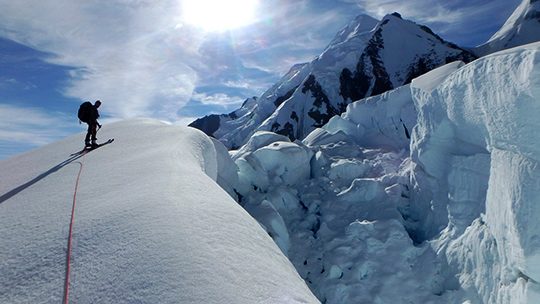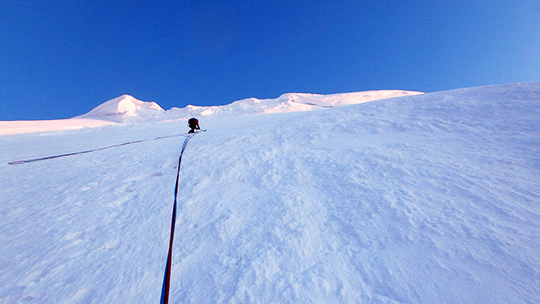
[Photo] Camilo Rada
Located in the Yukon Territory’s St. Elias Range between Mt. Bering (ca. 3600m) and Mt. Baird (ca. 3480m), Mt. Malaspina (3776m) had seen only one documented attempt by a Polish-Alaskan expedition in 1976. On August 15, Camilo Rada of Chile and Natalia Martinez of Argentina became the first to summit the peak, the highest named, unclimbed peak in North America. They rated their 1900-meter line up the peak’s East Ridge TD AI2 55-65 degrees.
“[I]t all depends on what criteria you pick to define what’s a mountain and what’s a secondary peak,” Rada told Alpinist. “If you pick any ridge of a high mountain, Denali, Logan, Foraker, St. Elias, etc., there are plenty of sub-peaks and rocky gendarmes that are much higher than Malaspina and are still unclimbed.”
Rada, a PhD student at the University of British Columbia, and Martinez, a ski instructor and mountain guide from Whistler, B.C. climbed the peak as part of their Uncharted project, “which combines mountaineering, historical research and mapping,” their Facebook page states. While the Unclimbed project originated in Patagonia, Malaspina offered an opportunity for the project to expand beyond the Southern Hemisphere because this was an unclimbed mountain in an otherwise well-explored area.
The team spent three days looking for the safest passage up the mountain. “The most challenging [part of the climb] was choosing the route,” Rada said. “[A]s we studied possible lines, we saw pieces of rock falling spontaneously from multiple places, including the ones that seemed the best options to climb. [We] discarded the rock [option] and concentrated in finding the safer line over ice.” He describes the rock as “dark, extremely fractured and brittle.”

[Photo] Camilo Rada
They planned to set up one or two intermediate camps as they climbed their route, but decided to make their summit attempt in one push after being forced to dismantle their high camp after seracs broke free near them.
Rada and Martinez left base camp shortly after midnight on August 13 and began the approach to the col between Malaspina and Mt. Baird. They traveled quickly through avalanche-prone terrain, simulclimbing 300 meters of snow and ice beneath a hanging glacier before reaching the East Col.
Once at the East Ridge, they built an igloo-like shelter where they rested for a few hours, “surrounded by the breathtaking spectacle of a Northern Lights storm,” Rada wrote in his trip report. From here, they continued over easy snow slopes and a few vertical steps to reach the summit at 2 p.m. on August 15.
They descended the mountain in fifteen rappels following their line of ascent and reached base camp at 8 a.m. on August 16, having spent a total of 55 hours on the mountain.
The previous team to attempt Mt. Malaspina “turned back because of the extremely narrow, ice-rimed ridge where protection was inadequate,” Carl Tobin wrote in the 1978 American Alpine Journal.